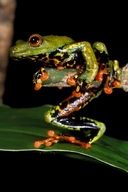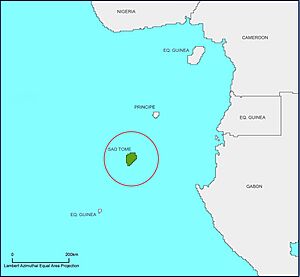Hyperolius thomensis facts for kids
Quick facts for kids Hyperolius thomensis |
|
|---|---|
 |
|
| Conservation status | |
| Scientific classification | |
| Genus: |
Hyperolius
|
| Species: |
thomensis
|
 |
|
| range | |
| Synonyms | |
|
Rappia thomensis (Bocage, 1886) |
|
The Hyperolius thomensis is a special kind of frog that lives only on the island of São Tomé. This island is part of the country São Tomé and Príncipe. People often call this frog the São Tomé reed frog or the São Tomé giant treefrog. It's known for being the biggest type of Hyperolius frog!
Contents
About the São Tomé Giant Reed Frog
Naming and Family Tree
This frog was first named by a scientist named José Vicente Barbosa du Bocage in 1886. It belongs to a group of frogs called Hyperoliidae.
Sometimes, scientists group this frog with another similar frog, Hyperolius molleri. These two frogs are very closely related. They can even have babies together!
What Does the São Tomé Giant Reed Frog Look Like?
These frogs come in different sizes. Adult males are about 2.7 to 4.1 centimeters long. Adult females are a bit bigger, measuring about 3.6 to 4.9 centimeters.
Their backs can be brown, green, or even blue-green. Their bellies are a mix of white, orange, and black patterns. The underside of their legs also has cool orange and black designs. Male frogs have tiny spines on their backs. Their eyes have pupils that are shaped like a horizontal line.
Where the São Tomé Giant Reed Frog Lives
Habitat and Home
The São Tomé giant reed frog lives in old, natural rainforests. You can usually find them in places high up, often above 800 meters (about 2,600 feet). Sometimes, they are found a bit lower, around 350 meters (about 1,150 feet).
Reproduction and Life Cycle
These frogs are unique because they lay their eggs and their tadpoles grow inside tree holes! Many frogs can use the same tree hole for breeding.
Protecting the São Tomé Giant Reed Frog
Why This Frog Needs Help
Scientists are still learning about all the dangers this frog faces. One big problem is habitat loss. This means the places where the frogs live are disappearing.
People are cutting down forests for farms, raising animals, getting wood, and building new homes. All these activities can harm the frog's home.
Understanding Frog Diseases
Scientists have found a type of fungus called amphibian chytrid fungus (Bd) on São Tomé Island. This fungus can make frogs sick. They found signs of this fungus from as far back as 2001.
Even though the fungus is there, scientists haven't seen many sick or dead frogs in the wild. However, there's a very strong type of this fungus (called Bd-GPL) on the island. This makes scientists worried about what it could do to the frogs in the future.
Protected Areas
Luckily, some of the areas where these frogs live are protected. For example, they can be found in the Parque Natural Obô de São Tomé. This park helps keep their rainforest home safe.


